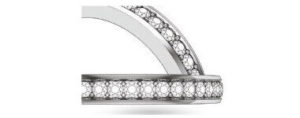
Grain set rings are set with diamonds or coloured stones held, quite literally, within grains of metal that are raised from the ring to hold each stone in a precision setting. For each small stone this process involves drilling a ‘seat’, or raising a small piece of metal from the ring where the stone will sit. Next the stone is placed in the gap, leaving the raised ‘grain’ of metal exposed to be set over a minimum of two edges. In order to set the stone the setter will use a series of tools to round the edges of the metal. This is to ensure the edges don’t cut into the stone and provide the pretty beading effect associated with grain work.

As with invisibly set diamonds or gemstones, grain set stones are an ideal way of setting small accent or additional stones into the shoulders of an engagement ring.

Unlike invisibly set stones, grain set stones are not secured all the way around but generally at four equally spaced points around the stone. This produces an apparent square shape.

Grain setting is a great way to add a subtle splash of colour to an otherwise white diamond solitaire or, conversely, a great way to add a touch of diamond sparkle to a less flashily coloured central gemstone.

The shape of the grain set stone does not have to be round or square. For example, an oval shaped stone can be good for matching an oval cut central diamond. One could also experiment with a mixture of shapes, including heart, marquise or pear shaped stones on the band.

When choosing to grain set stones in the shoulders of an engagement ring there needs to be enough depth of metal around the stones to accommodate them. Therefore, this needs to be taken into account at the design stage rather than adding stones at the final stage.

